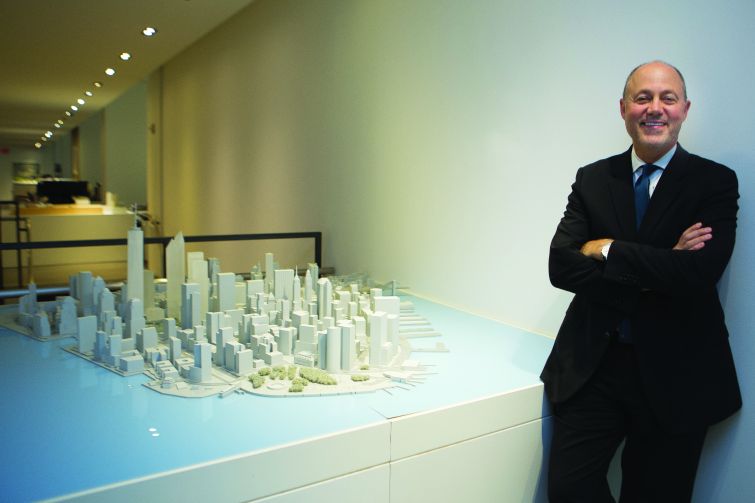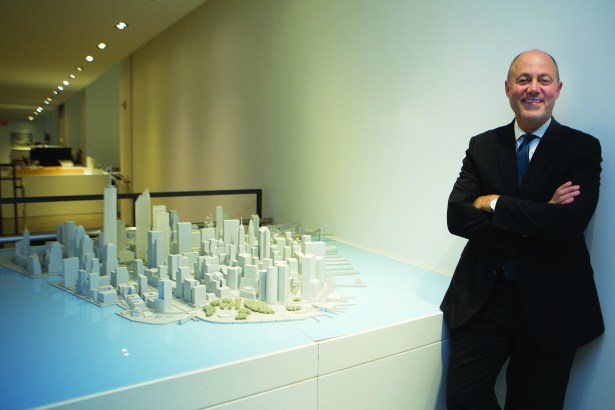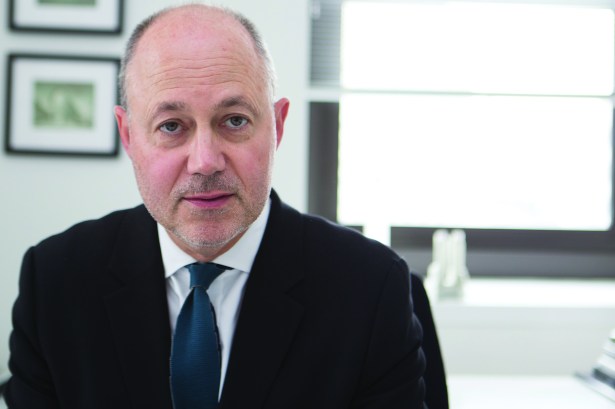SOM’s Mega-Project Manager Dishes on 1 WTC
By Tobias Salinger October 15, 2014 11:30 am
reprints

Models, awards and pictures from projects all over the world adorn the walls and corridors of the Lower Manhattan offices of Skidmore, Owings & Merrill, but the World Trade Center assemblage stands apart from all the rest. There are the gleaming pictures of Dubai’s 2,716-foot Burj Khalifa, a framed certificate recognizing Midtown’s Lever House for the 1980 American Institute of Architects’ 25-year award and the awe-inspiring design portfolio that includes seven of the world’s tallest 15 buildings and over 100 New York City structures. But they give way to a transparent scale model of the World Trade Center complex that’s all alone next to conference rooms and the executive offices where managing partner T.J. Gottesdiener oversees design, construction and planning at the firm’s New York City office.
The opening of 1 World Trade Center in the next few weeks will usher in a new era both at the site that’s attracted national and international attention and at the firm that started in 1936 and now boasts 1,200 employees in 10 offices worldwide. Thirteen years after the 9/11 tragedy took 2,753 lives in New York, the brand new anchor building of the redesigned Trade Center both illustrates Mr. Gottesdiener’s technical and administrative skill as a project manager and reaffirms the prominent architecture firm’s ability to create structures that rise to limitless heights from complex construction sites.
“Anybody who says this has taken a long time is shooting from the hip,” said Mr. Gottesdiener, a partner at SOM since 1994. “I think this has been a very inclusive process, a very public process, and, for many families, a very painful process. This is a Herculean effort and I think 13 years is the blink of an eye in the life of an urban development.”

Mr. Gottesdiener, a 59-year-old married father of one and an Upper West Side resident, started at the firm in 1980, and has worked on the planning, design and construction of over 13 million square feet of commercial development, according to SOM. David Childs, SOM’s chairman emeritus, picked Mr. Gottesdiener to be his project manager for works like the two SOM towers at 7 World Trade Center and 1 World Trade Center, the Time Warner Center opposite Columbus Circle and the former Bear Stearns headquarters at 383 Madison Avenue. And while Mr. Childs’ name is attached to those works in the headlines, he cites Mr. Gottesdiener as having “an equal relationship” with him on the projects.
“Being able to step up to that role was very key on these big complex projects,” Mr. Childs told Commercial Observer. “He’s a good team player. He doesn’t just sit up in his office and run numbers.”
The firm, founded in 1936 by Louis Skidmore, Nathaniel Owings and John Merrill, has finished 10,000 projects in 50 countries, including United States examples like the Willis Tower and the John Hancock Center in Chicago, the Hirshhorn Museum and Sculpture Garden on the National Mall in Washington, D.C., and the campus of the U.S. Air Force Academy. Five of SOM’s projects—the Lever House, the Air Force Academy Cadet Chapel, the Hancock Center, the Weyerhauser Corporate Headquarters in Washington state’s Federal Way and the Hajj Terminal of King Abdul Aziz International Airport in Jeddah, Saudi Arabia—have won the American Institute of Architects’ 25-year award that one project worldwide receives each year for continuing excellence.
“The staying power to be able to do buildings that stand the test of time defines the firm,” said Rick Bell, executive director of the American Institute of Architects’ New York Chapter, who said he knows Mr. Gottesdiener well. “[Mr. Gottesdiener] really emerged as a leader. He was always there in the background as a designer and a luminary before he assumed the visibility that he has now.”
And Mr. Gottesdiener, a Cooper Union graduate, has certainly participated in other high-visibility projects besides the World Trade Center. He noted future buildings like the 99-story Pertamina Energy Tower for Indonesia’s state-owned energy company in Jakarta that’s slated to save 80 percent of emissions over its peers and a 444-seat elementary school for P.S. 62 on Staten Island that will have a net zero impact on the city’s energy grid. And the firm’s three stations planned for completion next year in Fort Lauderdale, West Palm Beach and Miami along the privately developed, 235-mile All Aboard Florida express passenger rail service will culminate in a hub in downtown Miami that features rail lines elevated 50 feet in the air with retail shops beneath.
“We know what train stations or hubs can do for a city, a la Grand Central or Penn Station,” Mr. Gottesdiener said. “I think it’s going to attract a different environment than Miami is used to—it’s used to the car culture.”
|
“The staying power to be able to do buildings that stand the test of time defines the firm.” |
The new Trade Center has been attracting tenants ahead of its planned opening. Available space in the World Trade Center submarket, which includes both the Trade Center buildings and nearby Brookfield Place, has fallen by more than 45 percent over the past year to 1.87 million square feet of total available space in an area that’s seen a collective 11.6-percentage-point drop off in vacancy rates, according to the latest quarterly report from Cushman & Wakefield. The area’s 2.3 million square feet of transactions in the past 12 months represents a 344 percent increase over the previous year, the company’s figures say.
At 1 World Trade Center, new leases this year like those for ad agency KiDS Creative, co-working and virtual office space provider Servcorp and Cushman & Wakefield add up to nearly 100,000 square feet of new deals in 2014, with more deals to be announced soon, said Eric Engelhardt, the director of leasing at 1 WTC for the Durst Organization, which owns a $100 million joint development stake in the 3-million-square-foot Port Authority of New York & New Jersey property. The building, which is almost 60 percent leased, is “significantly ahead” of leasing for comparative skyscrapers and office buildings at this stage, Mr. Engelhardt said.
“The aggregate square footage that we’ve already pre-leased can make up most buildings twice,” he said. “Sure we’ve got a million square feet to go, but we’ve leased 2 million square feet already.”
The height and design of 1 WTC certainly plays a role in attracting the tenants, Mr. Engelhardt added. The structure juts 1,776 feet into the sky from its square base in an octagon floor pattern formed by eight isosceles triangles in the external glass structure that surrounds the enclosed core with extra-wide exit stairways and enhanced elevators that protect occupants in the tallest building in the Western Hemisphere. The simple, clear design is “very much about responding to the site,” Mr. Gottesdiener said. But the story of the building of 1 WTC—a process that started in public design conferences in December 2002 about the rebuilding of the 16-acre Trade Center site, evolved from master planner Daniel Libeskind’s competition-winning design for the complex and transitioned the building in April 2006 from Silverstein Properties back to the Port Authority—won’t end with the opening of the building.
“I don’t think of it as closure,” Mr. Gottesdiener said. “I think I’m proud to be a part of it. I’m pleased that SOM was involved. I think it’s a great step forward for Manhattan, for the city, for the country. If you wrote this as a script, this would be a great way to continue the story.”
|
“Anybody who says this has taken a long time is shooting from the hip” |
Yet the building’s opening will move the firm on to future pursuits, like the school, the Florida train stations and the Indonesian skyscraper. Back in Manhattan, Mr. Gottesdiener is also working on transforming the old Farley Post Office into an Amtrak hub across the street from Madison Square Garden at Moynihan Station, a project that has been delayed for years amid funding needs. Complex projects certainly make for drawn-out construction processes with no small share of criticism and scrutiny, but Mr. Gottesdiener welcomes the challenge.
“There’s a separation between an architect and an artist,” Mr. Gottesdiener said. “Architecture is very much a collaborative effort. It has to fit in a function and a community. What you call criticism, we think of as collaboration. Nobody likes to be told, ‘I don’t like what you do,’ or ‘someone has a better idea,’ but I think it makes the projects better.”


